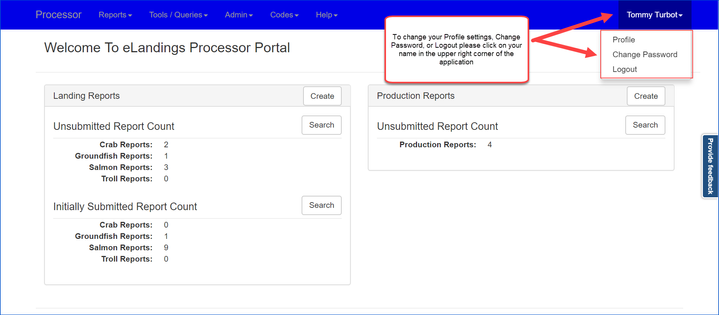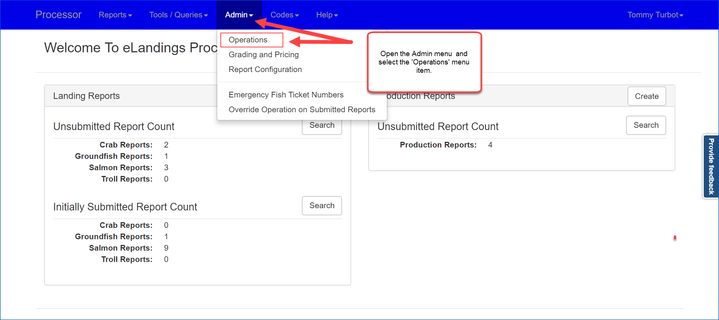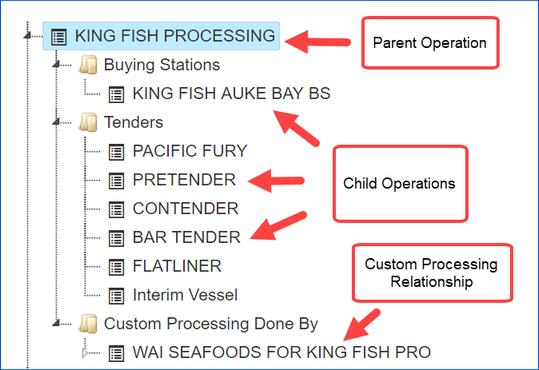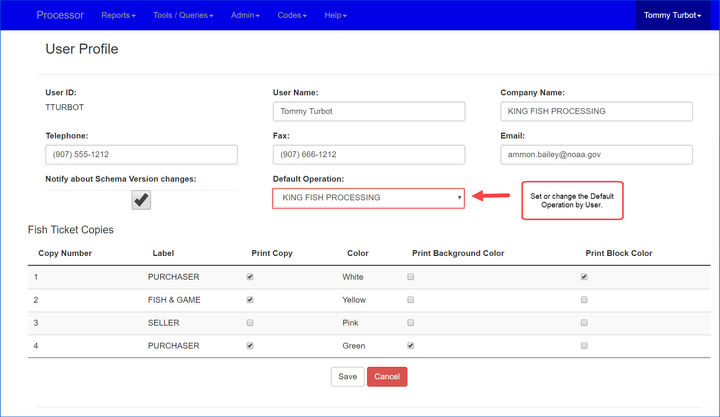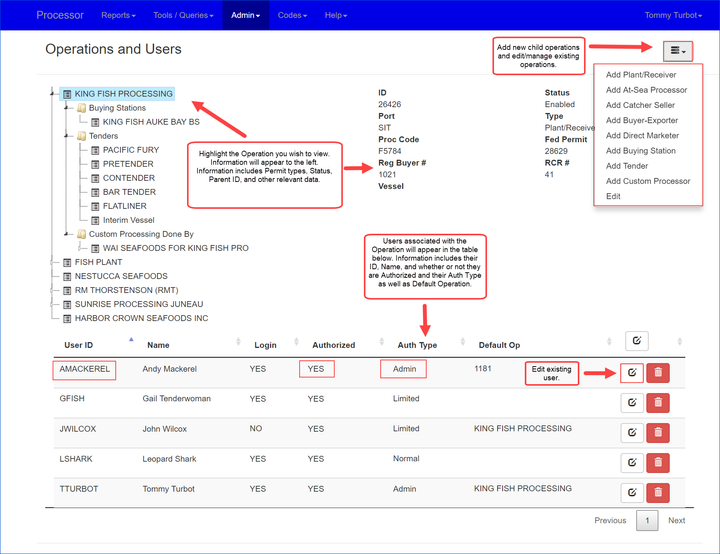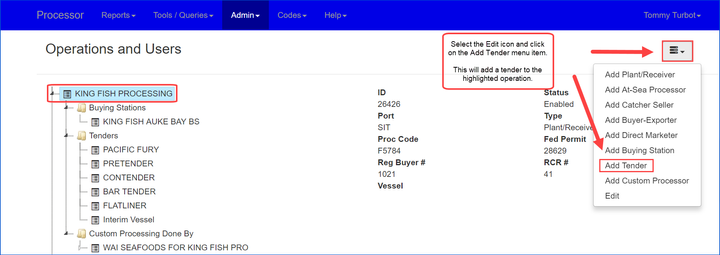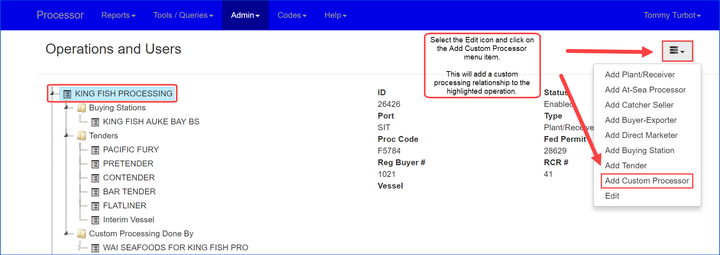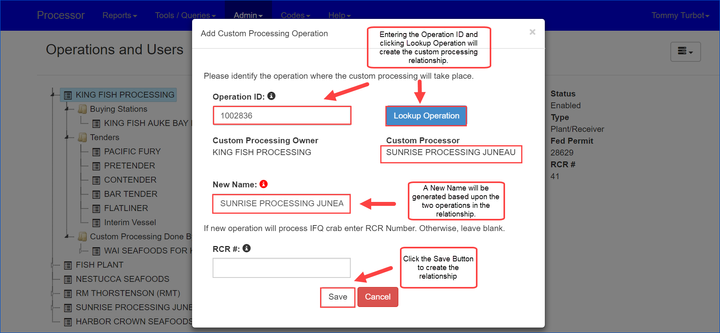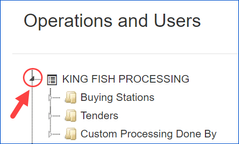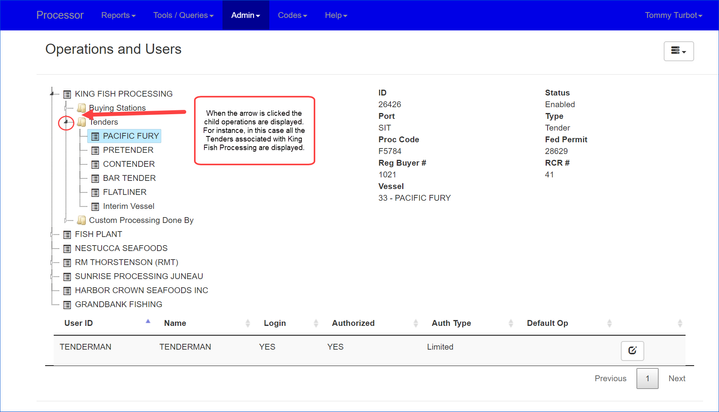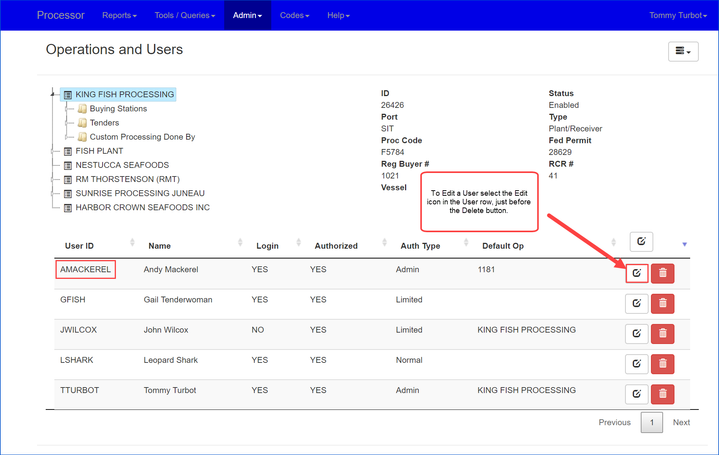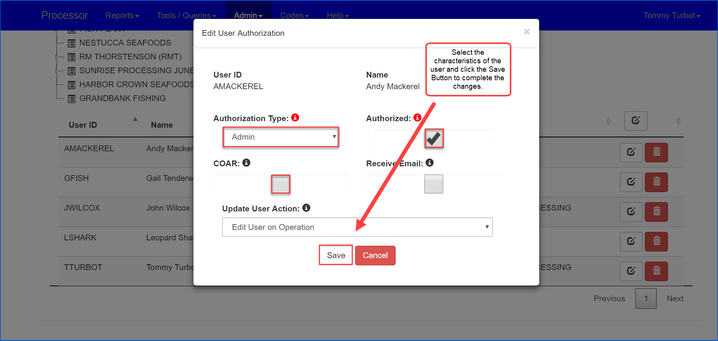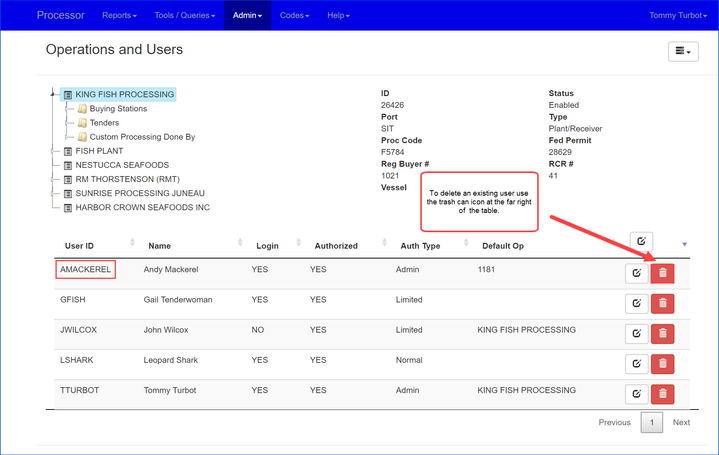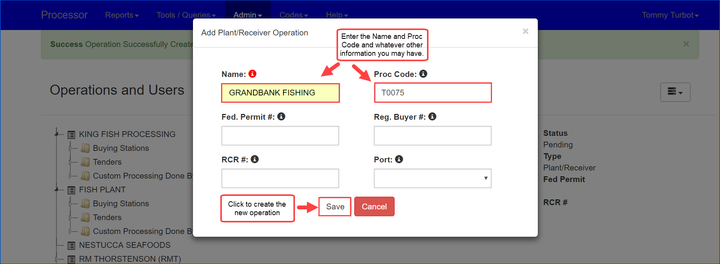eLandings User Manual
Administer Operations in eLandings HTML5
Operations are defined as an entity that receives seafood product and is required to complete landing and production reports, as well as IFQ reports, and also has a unique and valid Fisheries Business License – ADF&G Processor Code. Operation entities include seafood plants, at-sea catcher processors and floating processors, catcher-sellers, direct marketers and buyer-exporters. Several permits and licenses can be associated with an operation, including a Fisheries Business License (AKA Processor Code), a Federal Processor Permit, a Registered Buyers Permit, and a Registered Crab Receiver Permit.
Authorized users are assigned to each operation with a unique id. To access the data of an operation that specific user must be assigned to that specific operation.
When a new child operation is established by the parent plant by an administrator, only that administrator is assigned to the new operation. All additional users must be added even if they are an authorized user, including an administrative authorized user, with the parent operation.
Authorized users that use the Search function in the eLandings Web Application or use the Data Extract tool to extract data will need to be assigned to all operations (including child operations) that they need to access data for. If the user needs access to all data records associated with the seafood processing facility, that user must be authorized for all parent and child operations, including custom processing relationships.
What About the COAR Report?
The authorized user to generate and submit the COAR must be authorized on the parent and all child operations, including custom processing relationships.
Recommendations
We recommend that you periodically review all operations, including custom processing operations. Tenders can be deleted and custom processing relationships or buying stations closed, upon request. We hope you will periodically review user accounts associated with your parent and child operations. Remove users that no longer work for your facility. If you have users that need full access to data records for the parent plant and all child operations, make certain that individual is listed on all operations, including custom processing relationships.
When you create a new child operation, make certain to add at least one additional administrative user to assure that the operation administration tasks can be completed in the event of absence.
If you request a report and suspect that some data records are absent, review all child operations to determine if you are authorized. You may need to consult with an administrator authorized for the parent operation.
To manage Operations in the eLandings Web system:
- Login to the eLandings Web Application using your User ID and Password.
- Click Login.
The Processor Portal page will open.
There is also a Profile link which is available for all authorized users of the eLandings system and enables the customization of report displays, number of decimal points to display, itemized catch lines, etc... It also allows users to update email addresses, select their default operation, and choose printing options.
Recommendations
We highly recommend that end users review their Profile annually to ensure the application meets their unique expectations.
To access the operations associated with your User ID:
- Open the Admin Menu.
- Select the Operation Menu Item.
Also note the location of the Grading and Pricing button directly under the Operation selection on the Admin menu.
Operations are defined as an entity that receives seafood product and is required to complete landing and production reports, as well as IFQ reports, and also has a unique and valid Fisheries Business License – ADF&G Processor Code.
For the purposes of this document, we will refer to this type of operation as a parent operation.
- A parent operation can be a plant receiver, an at-sea processor, a catcher/seller, or a buyer/exporter.
- A parent operation may have child operations that share the same processor code.
- Child operations include buying stations and custom processing relationships.
In the following example, King Fish Processing is the parent operation, with buying stations, tenders, and custom processing identified by relationships. Management of these operations will be discussed in detail later in this document.
The User Profile, available at the main Processor Portal screen (see above), allows you to set a default operation that is displayed when you first login to eLandings.
Note the Default Operation for user Tommy Turbot is King Fish Processing.
Processors with more than one processing facility frequently have users that are authorized for multiple operations.
The Operations Main Menu
When you select Operations from the Admin Menu, the Operations and Users page will display.
- If you do not have Administrative authorization, you will not be able to access the Operations and Users section of eLandings Web.
- Depending on the number of parent operations you are authorized to administer, one or more parent operations will be displayed on the main menu.
- To display the operation permit profile, simply click on the name.
- This action displays operation details; all users associated with this operation, and allows for the addition of dependent operations and management of users.
- As you review the screen shot above, note the symbol to the left of the King Fish Processing operation.
- This symbol indicates that this parent operation has child operations. Harbor Crown Seafoods Inc. is an example of an operation that does not currently have dependent operations.
Operation Elements
- Operation ID - the numeric ID that identifies the operation in the system. This ID is a useful shorthand when identifying operation while talking to eLandings support personnel, and coordinating with business partners in setting up custom processing operations.
- Port - the physical location of the operation
- Proc Code - the ADF&G processor code or intent to operate license, often referred to as the metal code plate
- Registered Buyer# - the registered buyer permit number which authorizes the person on the permit to receive and make an IFQ landing by an IFQ or CDQ permit holder
- Status - the status of the operation. For a more detailed explanation see Operation Status. Operation statuses you will see are:
- Pending - this status means the operation has been created but has not been approved by the overseeing agencies.
- Enabled - the normal status for operations that are in use and are able to submit reports.
Superseded- Operations are defined by the specific permit combinations entered when registering in the eLandings system. If any permits related to your operation change, this signifies the need to supersede previous operations. This function will enable users to view all reports made by an operation despite any changes in the pieces that define a specific operation.
The capability to supersede an operation is new function that is not currently available. It will be available in a future release.
- Closed - the status indicating that an operation is no longer active, and cannot submit new reports.
- Type - the type of the operation, as specified during setup.
- Catcher Exporter - A Catcher Exporter operation is a vessel that catches and sells their own unprocessed or limited processed catch within or out of the country. Catcher Exporter operations can have custom processing done for them and export that catch. However, they cannot processor or do custom processing for others. Cannot purchase.
- Catcher/Seller (CS) - A vessel that catches and sells unprocessed or limited processed catch to individuals (e.g. via dockside sales) for personal consumption but not for resale. Catcher Seller operations cannot do custom processing for other, nor can they have custom processing done for them.
- Catcher Vessel (CV) - A vessel that actively engages in catching product before transferring it to a tender vessel for trans-shipment to a processor.
- Buyer Exporter (BE) - Receives catch from fishers, but exports the catch out of the country, usually to Canada, without processing the catch into other products.
- Direct Marketer (DM) - Receives catch from fishers, but exports the catch out of the state, without processing the catch into other products.
- Plant/Recievers (PL) - A shore based processing plant or seafood receiver. These are the most common type of operation, and are able to do custom processing or receiving on behalf of another operation. Usually the parent operation of other types.
- Salmon Receiver - A Registered Salmon Receiver is an any Processor or Receiver that is receiving federally managed salmon, including transporting fish from the initial point of offload to the point of processing or sale.
- At-Sea Operations (AS) - An At-Sea operation is a Catcher/Processor, mothership, or floating processor that is receiving or processing fish in State waters and/or in waters of the EEZ off the coast of Alaska away from an established port. At-Sea operations can also do custom processing or receiving for another operation. The following are types of AS operations:
- Catcher Processors
- Motherships
- Inshore Floating Processors
- Custom Processing Relationships (CP) - The purchaser/owner of the seafood product may have another processor or operation receive, expedite, or process seafood on their behalf.
- Buying Stations (BS) - Receives unprocessed catch from vessel for trans-shipment or delivery to a PL or mothership but does not process the catch itself.
- Tenders - A tender operation is a vessel that is attendant to catcher vessels and is used to transport or ferry unprocessed fish or shellfish received from another vessel to a shore side processor or mothership.
- Fed Permit - required permit for processors that receive or process groundfish harvested in the GOA or BSAI.
Operation Definitions
See Operation Definitions and Operation Types and Requirements to familiarize yourself with the various operation types and use cases
View and Add Dependent Operations
Unlike the previous version of eLandings most of the Operations management can be completed on the Operations and Users screen.
For instance, adding operations and adding and editing users.
From the Operations and Users screen you can add tenders, buying stations and custom processors.
Add Tenders
A tender operation is a vessel that is attendant to catcher vessels and is used to transport or ferry unprocessed fish or shellfish received from another vessel to a shoreside processor or mothership. The tender is acts as an agent of the processor or mothership and passes the product along to their parent operation for processing.
To add a tender, select the edit icon and click on the Add Tender menu item.
- The User ID of all tender operations will be TENDERMAN. This is a generic account established to simplify and streamline administration of tender operations in eLandings, PTI, and tLandings.
- Select Add Tender from the Edit menu.
The Add Tender dialog will open.
- Select or Enter the ADFG Number of the Tender.
- Click the Save Button to associate the vessel with the parent operation.
Add Buying Station
A Buying Station is an operation that receives unprocessed catch from vessel for trans-shipment or delivery to a shoreside processing plant or mothership and that does not process those fish (NMFS 679.2 Definitions). A buying station can be considered an annex of the plant or mothership for which it is doing receiving. Buying Stations may be completely shore based, such as a truck being loaded for transport to a distant plant, or may be a scow (a barge-like vessel). Tenders are a special type of buying station that have their own operation type.
The process of adding a buying station is quite similar.
- The Proc Code, FPP, and RB permits will be taken from the parent operation automatically.
- Select Add Buying Station from the Edit menu.
The Add Buying Station dialog will open.
- Enter the Name of the new Buying Station.
- If the buying station will receive IFQ crab, a unique Registered Crab Receiver number must be provided.
- A Vehicle License Number is not a required field, but must be completed if you are a vessel applying for a federal fishery permit and you do not have USCG documentation.
- Click the Save Button to associate the buying station with the parent operation.
Add Custom Processor
This is a special operation type that involves an "owner" of fish in conjunction with a fish "processor". This type of operation must be setup in eLandings by the "owner" of the fish and requires permits from both operations involved, this specifically defines it in the system.
The purchaser/owner of the seafood product may have another processor or operation receive, expedite, or process seafood on their behalf. The operation that is in possession of the seafood product, but not the owner or a direct agent for the owner is a Custom Processor. The eLandings interagency working group define a Custom Processor as a processor, business, or entity that provides the service of seafood receiving, expediting, or processing but has not purchased (does not own) the seafood, and is not acting as an agent for the owner.
The owner of the catch must establish a custom processing operation for each plant that does the actual processing. This allows the owner of the catch to maintain visibility and control of the landing reports. The landing reports are usually created and submitted on the owners behalf by users at the plant that are doing the custom processing. The owner of the seafood product must have a valid ADF&G Processor Code license and the processing facility will need to have their own receiving permits from Fish and Game as wells as NMFS. These permits are used to establish the custom processing owner operation. Once the operation is established, the users at the custom processing facility will be authorized to make landing reports for the custom processing owner operation. This is akin to providing the custom processor with the metal process code plate to create paper fish ticket records.
The advantage of establishing the custom processing owner operation is that it gives the owner the ability to review and access landing reports electronically as soon as they have been successfully submitted to the Interagency Server. They can also remove the authorization to access those reports should the business relationship be terminated.
Create a custom processing relationship:
- The permits will be populated based upon the parent operation permits.
- Select the Add Custom Processor item from the Edit menu.
The Add Custom Processing Operation Dialog will open.
- To create the relationship simply enter the Operation ID and click the Lookup Operation Button.
- Click the Save Button to create the relationship.
The new Custom Processor name will be auto generated, but due to character restrictions it may be cut off or truncated. You may choose to rename this relationship before clicking Save. Descriptive names are the best and will minimize confusion.
The User Agreement shall be reviewed and signed by the plant manager and covers all dependent operations and all authorized users.
All current operations shall be grandfathered into this modification of the User Agreement.
All child operations and all users will automatically be enabled, with the exception of the Custom Processing operation.
Custom Processing operations need to be reviewed by the eLandings support team prior to use.
Please continue to contact eLandings@alaska.gov for review of this operation type and to enable the custom processing operation.
Navigation in the Operation and Users Tree Structure
The open triangle symbol indicates that dependent (child) operations are attached to the parent operation or dependent operation category.
- To view them, simply click on the open triangle symbol.
- To contract them, click on the filled triangle symbol.
User Types and Definitions
There are several level of user authorization available in the system. For a more detailed breakdown including use cases see: Operation User Authorization Types
- Read-only - View reports but not edit or create them.
- Limited - Create, view, and edit reports until passed off to another user, at which point this user cannot view or edit those reports further.
- Normal - This is the standard user and can create, view, and edit Reports. The only limitations are that they cannot create a new user or modify the operation.
- Admin - Create, view, and edit all reports. Add users and administer operation attributes.
Adding Users to an Operation
To add a user to a primary or dependent operation such as a tender:
Tenders now all use the generic Tenderman user.
- Click on the operation you want to add a user to.
- Click the Edit icon above and to the right of the table.
This will open the Add User Dialog.
To enter an existing user:
- Enter the UserID
- Choose the authorization type
- If the person you are adding already has an eLandings UserID, you can click on the Add Existing User button.
New users can be added by completing all the required information in the screen shot below.
- Add action - options for adding the user
- Userid - the userid of the person you want authorized to report in elandings
- Authorization Type - the authorization that should be given to the user for the selected operation.
- Password - the password the user will use to authenticate themselves.
- User Name - the full name of the user.
- Company Name - the name of the company the user works for.
- City - the city where the user is primarily located when doing elandings work.
- State - the state where the user is primarily located when doing eLandings work.
- Telephone Number - the user's main contact phone number.
- Fax Number - the user's fax number, if they have one. Fax Number is not required.
- Email - the user's email address - required.
- Security Question - if the user forgets their password they can call the overseeing agencies to have it reset. The question should be easy for them to answer, but difficult for anyone else to answer or guess.
- Secret Answer - the answer to the security question.
When an existing or new user is added to an operation, such as JayZee (below), the user is automatically authorized*.
- If JayZee is a seasonal employee, you can simply unclick the authorization checkbox and remove his access to the eLandings System temporarily.
- When he returns from seasonal leave, check the authorization box.
- If he is no longer employed with your company, highlight his user account and select the ‘Remove User’ button.
* NOTE: You do NOT need to have a user agreement signed and submitted to National Marine Fishery Service or the Alaska Department of Fish and Game for final authorization.
We highly recommend that you have the new user read the eLandings User Agreement since processors and their employees are expected to comply with the agreement.
Edit a User
The Edit User is visible at the end of the row in the Users table.
- Clicking the Edit User button will display a dialog where the user authorization data can be edited.
- The user's default operation can be set, but only to one of the operations that you can administer.
This will open the Edit User Dialog.
- The Authorization Type for the user can be changed by selecting a new value in the dropdown. For more information see Operation User Authorization Types
- The user's authorization can be enabled and disabled by checking and unchecking the Authorized checkbox. This is the same as checking and unchecking the Authorized checkbox on the Users table.
- The users COAR reporting authorization can be enabled and disabled by checking and unchecking the COAR checkbox. This is the same as checking and unchecking the COAR checkbox on the Users table.
- Click the Save Button to complete the changes.
Clicking the Cancel button dismisses the dialog without saving the changes.
Delete User
The Remove User button will remove the selected user from the operation. This should be used when the user is not expected to do any work for the operation in the future, for example when an employee leaves an employment status.
To Delete a User click the trashcan icon at the end of the user row in the User Table.
Adding a New Independent (Parent) Operation
To add a new parent operation, select the appropriate operation type from Edit menu on the Operations and Users main page.
You will need to add the following information:
- Operation Name - the name that identifies the operation. This is a required field and has a maximum length of 32 characters.
- ADF&G Processor Code - the processor code (intent to operate license), sometimes called the F-code , is usually required.
- Federal Permit Number - the Federal Processor Permit (FPP) for shoreside plants or Federal Fisheries Permit (FFP) for at-sea processors. This is required if receiving or processing Federally managed groundfish or CR crab.
- Registered Buyer Number - the registered buyer permit number for IFQ Sablefish and Halibut. This is not required if no IFQ groundfish will be received or processed.
- RCR Number - the registered crab receiver permit number is required for CR crab.
- RSR Number - the registered salmon receiver permit number is used solely for transporting federal salmon from the initial point of offload to the point of processing or sale
- Vessel ADF&G Number - only required if you are an at-sea catcher processor.
- Port- the port location of the operation.
- For at-sea catcher processors enter FCP
- If acting as a mothership enter FLD
- If you are a stationary floating processor enter IFP
- For catcher/sellers enter your home port, this can be changed at the time of landing if selling in different location
The Add Dialog will appear (depending on the operation type selected above).
- Enter Name and Proc Code (required).
- Enter other information that you may have.
- Click the Save Button to create the new operation.
You will be associated to the operation as the creator. This can be changed later depending on the needs of the organization.
The new operation will be created and will show up in the tree hierarchy.
- To enable the operation you will need to print, sign, and fax the new operation registration form to NMFS.
- The form can be found by clicking the Edit menu to the top/left of the screen and selecting the newly enabled Print Registration menu item.
Until an agency staff person enables the operation, it will remain in pending status.
If you feel you've made a mistake you can always click on the Cancel Button.
The administration of operations is complex and does require periodic review.
Please retain this document and never hesitate to contact us if you have questions or need assistance at eLandings@alaska.gov.
PDF Print Link: Administer Operations in eLandings HTML5
How to Download and Print this Article as a PDF
Download:
Click the 3 dots (...) at the top right of the article
Click Export
Click Export to PDF
Wait for the PDF to load, and click Download PDF
Print:
Open the PDF
Print the PDF
Support Contact:
If you have any questions or concerns, please contact elandings@alaska.gov

